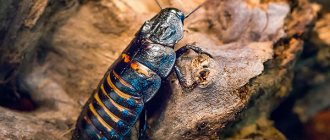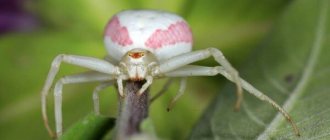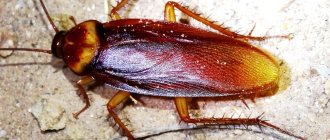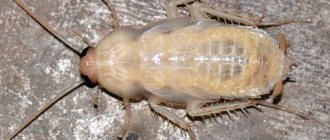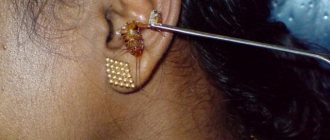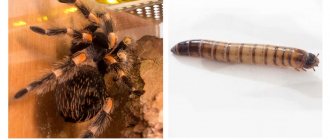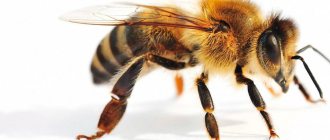External structure of cockroaches
The order “cockroaches” is quite numerous and numbers up to 7 and a half thousand species. In our territories, the most numerous is the red cockroach or Prusak, as it is also called. Black cockroaches are less numerous, with the American cockroach being a fairly rare species. The structure of cockroaches, despite their species, is almost identical, although they differ in size and color.
Interesting to know! The structure of modern cockroaches is practically no different from the structure of their ancient representatives of the order “cockroaches”, in the form of Ignaroblatta, which was found in fossils. Their size was 4 times larger than the Prussians, but at the same time they were smaller in size compared to modern giant cockroaches. Moreover, they were the most numerous representatives of this genus who lived within the ancient continent of Gondwana.
The structure of their body is considered quite perfect, so it is not surprising that these insects have retained all their basic qualities for many millions of years.
The cockroach has a flattened body, which allows it to penetrate through the narrowest cracks, while the body consists of 3 parts: head, chest and abdomen.
Main types of cockroaches: names and photos
Today, science knows about 7.5 thousand species of these insects. Most of them live in the tropical and subtropical zones of the planet. In the territory of the former USSR, only 55 species of cockroaches are found.
The most common species is the so-called Russian cockroach, or red cockroach (Blatella Germanica). It is curious that in Germany and the Czech Republic it is called the “Russian cockroach”. Individuals of this species live for about six months. The female Prussian holds about 40 eggs and can reproduce up to 7-8 times during the life cycle.
The second most common species is the black cockroach (Blatella Orientalis). It can most often be found in residential buildings and apartments, but it rarely climbs above the fifth floor. When it comes to food, the black cockroach is absolutely unpretentious - it can eat anything from the dinner table or feast on your waste from the trash can.
The next photo shows an American cockroach (Periplaneta Americana). This species is distinguished by extremely long antennae and increased mobility. Oddly enough, the birthplace of the American cockroach is Africa. From the “dark continent” it spread almost throughout the world along with products transported by sea vessels.
Madagascar hissing cockroaches are most often kept in apartments (on purpose). And they really sizzle! This sound accompanies the breathing process of these insects.
It is impossible not to mention one of the largest representatives of the order - Megaloblatta Longipennis. These insects live in South and Central America. First of all, they are interesting because they can not only run, but also fly.
Head structure
The cockroach's head is triangular in shape, and it is covered on top by a shield connected to the first segment of the chest. Therefore, you can see that only the back of the head peeks out from under the shield, and the rest of the head looks down. On both sides of the head there are compound eyes consisting of 1800 fragments. As a result, the insect perceives all objects in the form of a mosaic made up of many colored pieces. The eyes of cockroaches are not designed for detailed study of objects, but at the same time, the color resolution of these insects is 5 times higher than that of humans.
Interesting fact! Thanks to the presence of compound eyes, the cockroach is able to detect individual movements that follow with a frequency of at least 300 Hz. Therefore, he is able to see the movement of an object in slow motion, which helps him timely dodge flying objects, such as a slipper, for example.
In addition to these, one might say, compound eyes, on the front of his head there are 2 simple eyes, the functions of which have not been studied to this day. Experts say that thanks to these simple eyes, the insect can navigate perfectly in the dark.
The cockroach's long whiskers serve as organs of touch, smell and temperature determination. The whiskers are distinguished by the fact that they have nerve shoots that constantly send signals to the pest’s central nervous system. With the help of their whiskers, insects contact each other, and they can transmit and perceive the necessary information. After each molt, the whiskers of individuals grow by 1 segment, so you can determine how old the cockroach is. An adult may have about 80 of them, but this does not mean that the cockroach is 80 years old. Only specialists can do the calculations.
The insect's oral apparatus has a rather interesting structure, since each part of it is designed to perform separate functions. For example:
- The upper lip (lambrum) has a movable connection with the head and on its inner surface there are receptors that signal the composition of food.
- With the help of the lower jaw (mandible), the insect firmly holds food. The lower jaws look like curved plates with sharp teeth.
- With the help of the upper jaws (maxillae), the insect chews, grinds and grinds food. They are located above the lower jaws and are armed with chemoreceptors.
- The lower lip (labium) covers the oral opening from below and consists of several parts. Thanks to the presence of this lip, food particles do not fall down. In addition, the lower lip has taste and tactile receptors that help find food and analyze its origin.
- In the cavity of the oral pharynx there is a salivary gland and something similar to a tongue, thanks to which cockroaches drink water.
It is believed that the oral apparatus of these insects has not undergone significant changes over such a long period of their existence.
10 facts about COCKROACHS that you are better off not knowing
Description and structure
The black cockroach belongs to the order Cockroach. Representatives of this species are quite common in European countries . It also lives in Africa and Asia and is the closest relative of the eastern cockroach. However, these cockroaches are less common than their red counterparts.
You can maintain perfect cleanliness in the house, but due to the untidiness of your neighbors, cockroaches still spread throughout the house. Since representatives of this type of pest reproduce very intensively, they are forced to constantly look for new food. Favorable factors for their development are:
- trash in the house;
- unwashed dishes;
- sewage;
- garbage collectors;
- dampness in the bathroom.
- head;
- breast;
- abdomen.
Black ones are much larger than their red counterparts , their sizes reach 5 cm. The chitinous shell covering the body of a black cockroach is black or dark brown in color. The outer cover of the body is quite durable with a shiny tint, so it takes some effort to completely crush the insect. Its body is flat in shape, and this allows the insect to easily penetrate the smallest cracks and cracks in the wall and floor. The body is divided into three sections:
The segments forming the head section are fused together. There are two large eyes on the sides of the head. An interesting fact is that males have much better developed vision than females. Small segmented antennae, reminiscent of antennas, continuously perform oscillatory movements. The length of the whiskers is responsible for touch and vibration, and the male has longer whiskers than the female. His mustache is much longer than his body size.
In the thoracic region there are three pairs of legs that serve the insect for running and walking. The last two legs have wings. In the female they are shortened, so she cannot fly.
The abdomen of a cockroach consists of 10 segments; they are attached to the chest without constriction. The powerful mouthparts consist of an upper and lower lip and jaw. With the exception of the upper lip, all other parts of the oral cavity can be modified. The oral cavities of the cockroach are primitive, gnawing type. The insect easily chews and eats solid food.
The thoracic region and the purpose of the paws
On the thoracic part of the cockroach's body there are wings with elytra, as well as insect legs. Cockroaches, like any representative of the “insect” class, have 6 legs, that is, 3 pairs. Each tarsus is located on one of the thoracic segments and represents:
- Prothoracic legs, which have the shortest length and serve as “brakes” if the insect moves too quickly.
- Medium-thoracic paws that can move in any direction, providing the insect with high maneuverability.
- The metathoracic legs are designed to move the insect only forward. They are the longest in size.
The cockroach's paw is a rather complex mechanism, which includes 5 segments. The thighs, flattened in shape, are armed with spines below. The first 4 segments are armed with pads, and the fifth with claws with a suction cup located in the center. This allows the insect to crawl on both horizontal and vertical surfaces.
Interesting fact! Having relatively long legs helps the cockroach not only run fast, but also jump high. In addition, with the help of all 3 pairs of limbs, the cockroach takes care of itself from the head to the abdomen.
In other words, the insect uses 3 pairs of its legs for its intended purpose. Cockroaches are able to move along the surface at a speed of about 4 kilometers per hour. If a cockroach grew to the size of a cheetah, it could easily outrun it. With the help of sensitive hairs located on the legs, the cockroach assesses the situation around itself. In 1 minute he is able to change his trajectory up to 30 times.
Here, on the thoracic region, the wings with more rigid elytra are attached. Using the length of the wings, you can determine the gender of individuals: females have much shorter wings. These insects use their wings during the mating season, as well as when moving or falling. By spreading their wings, individuals demonstrate their readiness to mate. Despite the presence of wings, cockroaches cannot fly, although there is one species that lives in South and Central America that can fly.
How many legs does a cockroach have?
Now let's move on to the main issue of our article. So how many legs does a cockroach have? Answer: six, like all other representatives of insects. These are three pairs of powerful legs, each of which is covered with spines and fibers. With their help, cockroaches are able to quickly move along vertical surfaces, and even along the ceiling.
The foot itself has a segmented structure and consists of several joints. Scientists have found that cockroaches of advanced age (60-70 weeks) have severe pain, so it is quite difficult for “elderly” insects to climb up walls.
Cockroaches are not only fast, but also incredibly nimble and agile insects. They can reach phenomenal speeds for their size - over 5 km/hour. Moreover, in one second, cockroaches are able to change the direction of their movement several times. This is why they are so difficult to catch.
How many legs do other cockroach species have? And how many varieties of this insect are there? This will be discussed further in our article.
Abdomen: structural features
A maximum of 9 abdominal segments can be distinguished, although it actually consists of 11 segments. The anus is located on the tenth segment, and the last segment is formed by paired outgrowths that have no purpose, but represent a separate sign of a certain type of cockroach. These growths have been preserved for millions of years, indicating their relict origin.
The female has a special capsule (ootheca) at the end of her abdomen, which contains 12-16 eggs and subsequently develops into the hatched larvae. Under favorable conditions (availability of water and food), this capsule appears in the female every couple of days.
Interesting to know! During the process of growth and development, not only the size of individuals changes, but also their weight, which at the beginning of development is about 2 mg, and at the end of the process about 8 mg. The larvae, in comparison with the imago, do not have wings, cerci and spines on their legs, but have short antennae. After the fifth molt, the insects develop genitals and complete external resemblance to adult cockroaches.
According to University of Massachusetts professor J. Kunkel, cockroaches are endowed with basic driving instincts, such as hunger, thirst, survival and reproduction. In order to understand whether cockroaches have a brain, you should study its internal structure.
Does a cockroach have a heart and brains?
The main driving instincts that drive a cockroach are hunger, thirst, safety and sex. To understand whether a cockroach has a heart and brains, what its heart looks like, you need to study the anatomy of an ordinary red Prussian.
Today there are more than 4,000 species of cockroaches. Most of them live in tropical areas, but many of them have settled near people. Cockroaches are social animals; they do not like to live alone. When in groups, these insects produce pheromones that stimulate development and make them grow faster than individuals.
Internal organs of a cockroach
According to some claims, a headless cockroach can live for several days. Such possibilities are associated with the structure of the nervous system and other organs, which allows the cockroach to live without a head.
Structure of the nervous system
The central nervous system of the cockroach is formed by 11 independent nerve ganglia. In the head of an insect there are only 2, but large, nerve nodes. They are located under and above the pharynx, and are responsible for the actions of the eyes, whiskers and probes located on the lips of the cockroach.
3 thoracic nodes, together with the subpharyngeal node, control the operation of the oral apparatus, wings, paws and head muscles, as well as the muscles of the thoracic region.
In the belly of the insect there are six small nerve ganglia, the largest of which is the terminal one, which is responsible for the functions of the genital organs and sensitive cerci.
Important point! The internal structure of the cockroach is such that it can easily do without a head, especially since its breathing is not connected to the nerve nodes located in the head. There is no pressure in his circulatory system, so he does not bleed. At the same time, he does not waste energy while being immobile, so he can easily do without food. Under certain conditions, it can live without a head for up to 1 month.
The nerve fibers of a cockroach are connected to all organs of the insect, including the sense organs. The cockroach not only has unique vision, it also has excellent hearing. The insect's auditory receptors are located near the anus.
Circulatory system
The circulatory system is of an open type, while the cockroach’s blood is white and washes all internal organs, being in free circulation. The cockroach's heart is a tubular organ located in the dorsal pericardium. The middle sinus contains the intestines, and the thoracic sinus contains the nerve cord.
Due to the work of the tubular organ, hemolymph (blood) is pumped through the circulatory system. The work of the heart is carried out due to pressure differences resulting from the work of the muscles. Blood is pumped slowly, so cockroaches are quite sensitive to changes in ambient temperature.
Respiratory system
On both sides of the abdomen there are tiny holes called spiracles, through which the insect breathes. There are 10 pairs of them, which means that on each side of the abdomen there are 10 such spiracles. From these holes extends a whole system of tubes - tracheoles, which ultimately connect with 3 pairs of several large tracheal trunks. Oxygen reaches all organs by diffusion.
Important fact! Cockroaches are able to hold their breath for up to 40 minutes, blocking their spiracles, which allows the insect to survive in difficult living conditions.
As a rule, a cockroach, being stationary, expends practically no energy. It is believed that they are in a state of movement for only 25% of their lives, so cockroaches are also considered the laziest insects.
Digestive system
When food enters the cockroach’s mouth, it is moistened with saliva (previously crushed) and enters the goiter through the esophagus, after which it is sent to the gizzard. Therefore, the process of digestion of food begins in the crop and ends in the stomach. After this, the food enters the intestine, which consists of the foregut and hindgut.
Interesting moment! The foregut consists of several parts. Immediately behind the mouth opening there is a buccal chamber with 6 teeth. With their help, the insect additionally crushes the food that has entered the mouth.
In the intestines of a cockroach there is a full range of bacteria and fungi that help the insect digest food objects, including even inedible food of inorganic origin.
Feces and urine are released through one anus. Urine is collected using special channels. They collect toxins dissolved in water throughout the body and send them to the anus.
Reproductive system
Males have a rather complex reproductive system. For example:
- The testes are located in segments 4-6 of the abdomen.
- The reproductive system includes the fungal (utricular) gland.
- The seminal vesicles empty into this gland.
- There are also organs of copulation.
- The female reproductive system is no less complex and consists of:
- From the ovaries, 8 avarioles each.
- From a pair of oviducts that are connected to the vagina.
- From the genital chamber where eggs accumulate. And collateral glands are associated with this chamber, which secrete a special secretion for the formation of a capsule (ootheca).
- From the ovipositor.
After fertilization, a capsule is formed into which the fertilized eggs enter.
Important point! The human cell nucleus includes 46 chromosomes, which are responsible for the transmission of hereditary information. Cockroaches have as many as 48 of them, although this is in no way evidence of the unique complexity of their body. Similar (relict) species of insects are distinguished by a large number of chromosomes.
According to scientists, cockroaches are more primitive, but the presence of 2 extra chromosomes indicates that the insects are quite resistant to external manifestations. It was this factor that turned out to be fundamental, ensuring the survival of the species for millions of years.
Cockroaches: 9 interesting facts
- Tsar Peter the Great was terrified of cockroaches.
- Some representatives of this order of insects are used in rather exotic events - cockroach races.
- Cockroaches in sugar is one of the traditional dishes of Chinese cuisine.
- Without a head, a cockroach can live up to nine days.
- If desired, this insect can regrow lost limbs.
- A female cockroach lays about two million eggs per year.
- If a cockroach turns upside down, it will not have much of a chance to return to its original position.
- These amazing insects can hold their breath for 30-40 minutes.
- Every 15 minutes, cockroaches release gases, which contribute to the global warming of our planet.
Reproduction
Cockroaches are dioecious individuals with noticeable sexual dimorphism. The latter is manifested in morphological differences between males and females. Anyone can identify them. The male is smaller. Its wings are better developed, which allows it to fly short distances. The last segment on the male's abdomen has specialized outgrowths called styli.
The structure of cockroaches determines their ability to internally fertilize. After mating, the female lays eggs covered with a protective membrane called edema. Cockroaches are characterized by incomplete transformation. This means that the eggs hatch into larvae that look like adult insects. It is called imago. At first the larva is deprived of wings. It grows, molts and develops into an adult insect. This period lasts about four weeks. Individuals become sexually mature only after three months.
Cockroaches are very prolific. Over the course of her life, one female gives birth to more than a hundred individuals. She lays eggs repeatedly. And for this she does not have to constantly mate. The fact is that sperm can be stored in the female genital ducts for a long time.
Habitat and reproduction
Black cockroaches are in many ways similar to ordinary Prussians and love to settle next to humans. They prefer to live in humid and warm places because they cannot do without water and constantly need warmth. In hot countries, pests live and reproduce outside the living space. Insects are nocturnal and die at temperatures of 0°C and below.
In apartment conditions they give preference;
- bathroom;
- kitchen;
- combined bathrooms.
Pests thrive in secluded corners hidden by interior items, behind heating radiators, in the housings of household appliances, under sinks.
Black cockroaches live from several months to 3-5 years . The entire life cycle of an insect consists of three forms of development:
- egg;
- nymph;
- imago.
Mating occurs in the warm season, after which the females lay eggs in a chitinous cocoon. There they mature to the desired state. This organ contains approximately 16 eggs. While the female is carrying eggs, her abdomen increases slightly in size, but after a while she leaves them in a secluded place. The entire incubation period is 44 days , after which the larvae appear. In color they bear little resemblance to black cockroaches, but as they mature, individuals become much darker.
Why are cockroaches dangerous and where do they come from?
Since cockroaches, including black ones, come into houses and apartments from unsanitary places, they carry many pathogenic microorganisms with them. They are considered carriers of dangerous infections:
- dysentery;
- typhoid fever;
- helminthiasis;
- diphtheria.
These insects damage people's property and spoil and contaminate food. By chewing through insulation, they damage household appliances, since their oral apparatus is well developed. They are capable of biting a person in their sleep, especially for children when there are a lot of cockroaches in the house.
They can get into people's homes in several ways. This most often happens when people bring things home. For example, when coming from a business trip or visiting, you can easily bring things with cockroaches into the house. Most often, cockroaches penetrate the lower floors of multi-story buildings. There are often cafes, shops or restaurants on the ground floor. When such establishments begin to fight against insects, they begin to escape through the ventilation system to escape.
Cockroaches love to move through garbage chutes and sewer pipes , so they often get into people’s homes using these methods. If they appeared in the house, it means that this place is comfortable for them. They are attracted to unwashed dishes, a full trash can, a dirty sink, and high humidity.
Fighting methods
In ancient times in Rus', black cockroaches in the house were associated with prosperity and wealth. At that time they were protected and not destroyed, but now much has changed, and people began to fight them using various methods of destruction.
Kitchen cockroaches are more difficult to deal with than Prussians, since they are more nimble and hardy . There are several types of control for these pests. Preventative measures are the simplest of them all. This consists of constant compliance with sanitary and hygienic rules for maintaining the home.
The chemical method is more effective. You can use various chemicals, which are now offered in a wide range. The third proven method is the use of folk remedies. They are effective only when insects have recently appeared in the house, and there are still a few of them.
Features of cockroaches
These insects belong to the class insects, order cockroaches. Phylum arthropods, subphylum tracheal-breathing. The peculiarity of the black cockroach, which has wings, is its inability to perform independent directed flight. They can glide on their even well-developed wings, which in males cover the entire abdomen. But large females either have no wings or are practically undeveloped. Because of this, their abdomen remains open.
They, like all polyphags, feed on a wide variety of foods, eating bread, vegetables, fruits, paper, and even soap. Black and red cockroaches can be attracted to foods that have a pleasant and rather strong odor. Cockroaches cannot survive without water and need warmth. Another feature is to search for the most secluded, dark, damp corners where they can feel quite comfortable.
What attracts cockroaches
Research shows that cockroaches are attracted to each other. They sense pheromones released by nearby insects thanks to special sensitive zones on their antennae. In total, the cockroach mustache has more than a hundred segments throughout its entire length, each of which is responsible for receiving relevant information from the outside world.
There are many factors that attract many different types of cockroaches. Wild or tree cockroaches may be uncontrollably attracted to bright lights at night. After this, they often remain in the living space forever.

